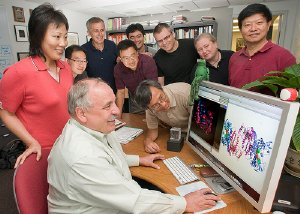For nearly a decade, researchers at the Midwest Center for Structural Genomics (MCSG), an international consortium led by Andrzej Joachimiak at the U.S. Department of Energy's (DOE) Argonne National Laboratory, have been patiently cracking the genetic code of important proteins. Using X-ray crystallography, researchers sketch an image of a protein's atomic structure-laying the basis for further studies and treatments by scientists all around the world. On Friday, July 17, they deposited their 1,000th protein structure into the Protein Data Bank.
 Andrzej Joachimiak (foreground) and colleagues (from right to left: Rg. Zhang, M. Cuff, Yc. Kim, B. Nocek, Y. Fan, K. Tan, J. Osipiuk, Cs. Chang, R. Wu) at Argonne's Midwest Center for Structural Genomics deposited the consortium's 1,000th protein structure into the Protein Data Bank.
Andrzej Joachimiak (foreground) and colleagues (from right to left: Rg. Zhang, M. Cuff, Yc. Kim, B. Nocek, Y. Fan, K. Tan, J. Osipiuk, Cs. Chang, R. Wu) at Argonne's Midwest Center for Structural Genomics deposited the consortium's 1,000th protein structure into the Protein Data Bank.
Founded in 2000, the MSCG works to discover how microbes interact with humans and the environment. It has identified potential new drug targets for anthrax bacteria and shed light on other pathogenic bacteria, including meningitis, salmonella, cholera and staph. After the H1N1 avian flu virus was identified in 2003, the MCSG raced to characterize one of its key proteins, a structure they nicknamed the “dragon” protein for its resemblance to a monstrous dragon’s head.
"The MCSG works to better understand the basic mechanisms of coexistence and survival for humans and other organisms," Joachimiak said.
The MCSG also studies basic aspects of bacterial life. It was the first to determine the three-dimensional structure of polyphosphate kinase 2, an enzyme thought to provide bacteria with a backup energy supply for survival. It has imaged proteins that help bacteria acquire virus resistance and proteins that allow bacteria to take over human cells. Other structures discovered by the MCSG reveal how proteins transport metals across cell membranes, how viruses synthesize their genetic material and how gene expression is regulated.
"These proteins provide important clues to the mysteries of human and environmental health by imaging the molecules that control and regulate it," Joachimiak said. "By visualizing the proteins, scientists are able to puzzle out the atomic details of how the biomolecule performs its task.”
With the structure in hand, other researchers can design molecules to improve or block that protein’s function—providing the basis for important new therapies. Each new structure goes into the Protein Data Bank, an international database of protein structures that can be accessed by researchers from around the world.
In addition to its direct work on proteins, the MCSG continues to refine its techniques—speeding up the imaging process for researchers all over the world. It has published more than 200 papers describing new tactics for high-throughput structural biology such as HKL3000, a new semi-automated system for controlling structure determinations experiments. Seventy-five percent of the 1,000 new structures have been determined in the past four years, and Argonne researchers believe they will be able to further improve quality and efficiency.
The MCSG is an international consortium of seven institutions: Argonne, Northwestern University, University of Virginia, University of Texas SWMC, Washington University, University of Toronto, University College London and the European Bioinformatics Institute. The MCSG is a component of the NIH-funded Protein Structure Initiative (PSI). Based at Argonne, the MCSG uses beamlines at the Advanced Photon Source (APS), the premier hard X-ray research facility in the United States. The APS is supported by the Office of Basic Energy Sciences within the DOE Office of Science (SC). The beamlines used by the MCSG are supported by NIH and SC’s Office of Biological and Environmental Research. Researchers using the APS have deposited more structures into the Protein Data Bank than any other light source in the world.
The PSI is a federal, university and industry effort aimed at dramatically reducing the costs and time it takes to determine a three-dimensional protein structure. The initial goal of the PSI was to make the atomic-level structures of most proteins easily obtainable from knowledge of their corresponding DNA sequences. The MCSG is one of four large-scale centers and is the first to reach 1,000 structures.
The PSI actively engages the scientific community in the selection of proteins for structure determination and is increasing its outreach, accessibility and impact on biomedical research via the PSI-Nature Structural Genomics Knowledgebase, a continually updated portal to PSI data, resources and latest developments. Biological material resources generated by the PSI are shared with the scientific community through the PSI-Material Repository and through collaborations with PSI investigators.